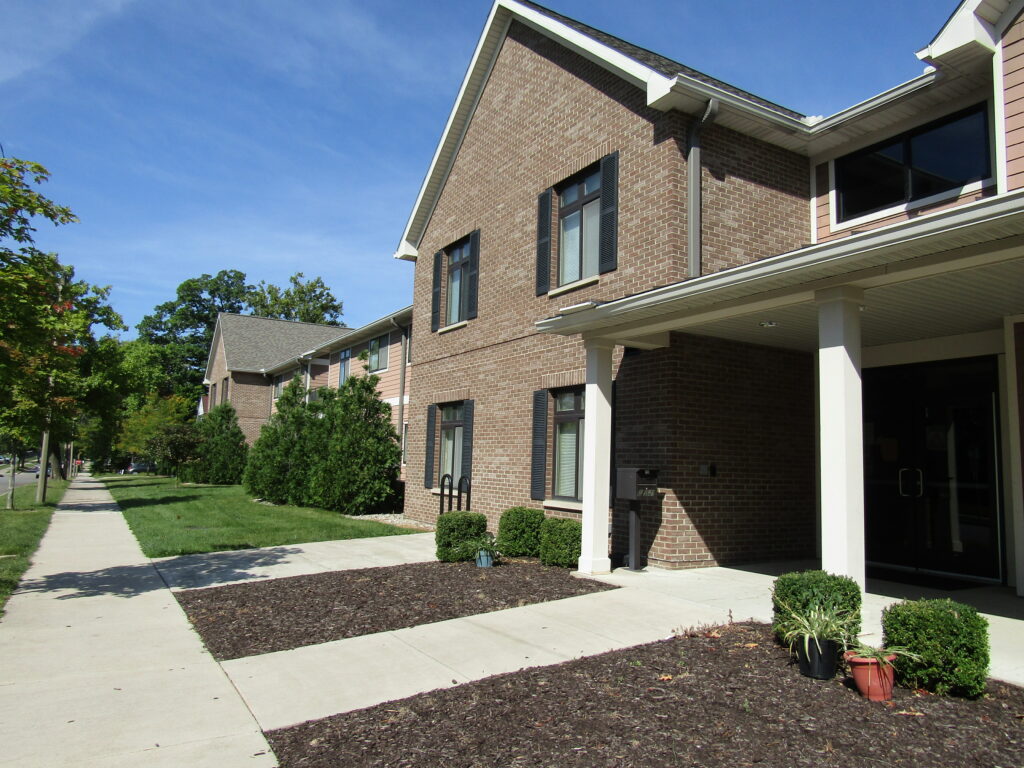“When we were in foster care, we weren’t allowed to get a license, we weren’t allowed to have a bank account or a phone. We weren’t allowed to have anything.” A young woman in Fort Wayne’s young adult housing described the steep learning curve she encountered at age eighteen.
The path to adulthood is fraught for any young person, but it presents additional challenges to those who age out of foster care without a support system in place. These kids are given $600 and a backpack on their eighteenth birthdays, but if they don’t have a birth certificate or a Social Security card, the next steps seem insurmountable.
At The Courtyard on Home Avenue in Fort Wayne, most residents used to be foster children. The Courtyard is an apartment complex that houses young adults, usually between ages 18 and 24. Priority is given to those who’ve aged out of the foster care system or who have been, or are in danger of becoming, homeless. It opened in 2014, financed from a mix of public and private funds.
At their recent tenant council meeting, a few shared their stories about aging out of the system.
One resident, a young man, provided some insights based on his experience. “I didn’t know how to do anything for myself besides cook. I didn’t know about managing a bank account or paying my rent every month. I didn’t know what a credit score was, either. There was a lot I didn’t know. I needed somebody I could trust.”
To help meet this need, organizations and entities in Fort Wayne interact, forming a web to help former foster kids remain sheltered.
“No one agency can do it alone,” said Samantha Oyler, Communications Coordinator for Stop Child Abuse Now (SCAN) Fort Wayne.
SCAN is the administrative agency that runs CHILL, which handles social services for The Courtyard. CHILL stands for Creating Hope, Instilling Life Lessons. Its overall goal is to help residents develop food security, life skills, and employment opportunities.
“It feels more like a dorm,” Oyler added, listing the various on-site facilities: two laundry rooms, a big commercial kitchen, a fitness center, and an arts and crafts room where they sometimes watch movies together.
Even with support from CHILL, The Courtyard maintains 22 MOUs (memorandums of understanding) with organizations around Northeast Indiana. These connections help residents do things like earn a high school equivalency degree, or obtain services such as job training and medical care.
Endia Cassel, SCAN’s Program Manager, says that The Courtyard uses two main concepts in their approach to supporting their residents. They provide permanent supportive housing, which means that as long as the residents fulfill their obligations, they can stay indefinitely at The Courtyard. They also use the “housing first” approach, which means that they first get the residents housed, and then help them deal with other issues of life.

Therefore, they cannot mandate that the residents take advantage of services, such as education or job training. It’s a resident’s choice to take advantage of the services on offer.
As a Section 8 property, The Courtyard caps rent at 30% of earnings for its 36 units. To qualify for residence there, an applicant must have 1) low to no income; 2) no arrest or felony convictions; and 3) a desire to become self-sufficient, learn life skills, and work toward personal goals. Residents in good standing have the option of transferring their Section 8 vouchers to other housing that accepts vouchers.
“Fort Wayne Housing Authority has a program too where they can give vouchers to young adults who are aging out of care, because we can only hold 36 (households) at a time, Cassel said. “The problem we’re finding is, there’s no place to take them. A lot of private landlords aren’t taking vouchers.”
In another part of town, Reverend Joshua Gale of the Just Neighbors Interfaith Homeless Network has contacts all over Northeast Indiana, and he calls on them to help the people who ask Just Neighbors for assistance. More people have asked for help lately, he says, because of rent increases. Affordable short-term rentals, he says, “almost don’t exist anymore.” Rents have increased, on average, from $400 to $500 per month within the past year.
Before the pandemic, Fort Wayne was already in a housing crisis, thirteenth in the U.S. for evicting people from their homes. Paired with statistics from the Alternative Family Services, which state that 20% of those who age out of foster care are homeless between ages 18 and 22, this can lead to unfortunate—and preventable—outcomes for these young adults.
“People who are already in poverty are vulnerable to others who simply don’t care about them. That’s what ends up being an issue for these kids and young adults, because what happens next?” Gale said. “We need more programs that are able to house kids as they’re aging out. Visibility and connection are the issue.”
Teamwork is needed to keep people housed. Gale calls this concept “the warm handoff.” When someone’s needs exceed Just Neighbors’ scope, he introduces them to someone who can step in and help. Doing so, he said, ensures a more positive outcome, especially with evictions.
“Our eviction work is in partnership with United Way, the city, and Indiana Legal Services. It has cut the eviction rate in half, in Fort Wayne. The only way it works is because of the partnership.” Gale said that the United Way’s ALICE report, which stands for “Asset Limited, Income Constrained, Employed,” describes the families they support.
Allen County’s United Way focuses on helping households with earnings that exceed the poverty level but are still below the basic cost of living. Approximately 34 percent of Allen County households are ALICE and poverty-level households.
“So far this year, about 2,500 evictions have been filed in Allen County, and our partnership has worked with 1,744. We’re seeing some trends there and hoping to dig into them.” Gale said the data shows racial disparities that require more investigation.
“To me, all solutions are in prevention,” he said. “It’s far less expensive for us to keep someone in a house than it is to move them or to shelter them in a homeless shelter.”
The good news is that local organizations, the city, and other entities have an awareness and an understanding of the challenges that young people face once they age out of the foster care system. They form partnerships, develop relationships with each other, and work together to support these young people and, by extension, everyone who calls Northeast Indiana home. Without a family, young adults from foster care are at higher risk of feeling unmoored and falling through society’s cracks, leading to homelessness and a lack of life management skills. The people behind Fort Wayne’s interconnected agencies and non-profits don’t fill all the gaps, but they do what they can to hold things together.
Resources
Court-Appointed Special Advocate Program

